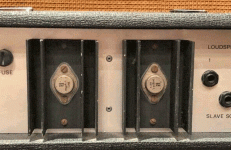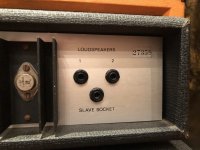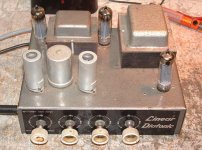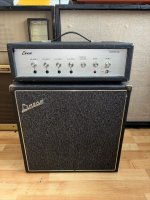Hi All
Anyone heard about this amp?
I have seen it for sale recently, but couldn't find any info on it anywhere.
Vintage 1970s Linear T40/60 MK1 Amplifier w/ Matching 1x12 Fane Speaker Cabinet | eBay
I am not even sure if it is a tube amp or transistor p.a.
Any one?
Thanks
Anyone heard about this amp?
I have seen it for sale recently, but couldn't find any info on it anywhere.
Vintage 1970s Linear T40/60 MK1 Amplifier w/ Matching 1x12 Fane Speaker Cabinet | eBay
I am not even sure if it is a tube amp or transistor p.a.
Any one?
Thanks
Ahhh ... it says it is not a valve amp. Sorry.
OK, it is a transistor. Really really rare amp. I have not seen or heard that amp in my 30 years of amp using experience. Have you?
OK, it is a transistor. Really really rare amp. I have not seen or heard that amp in my 30 years of amp using experience. Have you?
In the 1970s, everybody and his dog was building guitar amps (tho this is a voice-mike amp). They now seem "unique" or "rare" because a lot of them were crap.
Look at the bottles. (Yeah the text too but I never trust the seller.)
...I am not even sure if it is a tube amp or transistor p.a....
Look at the bottles. (Yeah the text too but I never trust the seller.)
Attachments
In the 1970s, everybody and his dog was building guitar amps (tho this is a voice-mike amp). They now seem "unique" or "rare" because a lot of them were crap.
Look at the bottles. (Yeah the text too but I never trust the seller.)
So true. Very clearly transistors (2n3055)
Also looking at the construction of this one, particle board and just an unknown circuitry + probably bunch of parts you have to replace.
Personally I wouldn't take it
Rare does not always mean good!
This is a transistor amp. They were made in the 1970's in Leeds, England I believe. They must be reliable as I have one which still works.
The Linear Products Co Amplifiers
Didn't know them until searching just now.
My bro' has an RSC Bass valve amp, which I didn't know was made by same company.
I'm sure he'll be thrilled when I tell him it was made locally.
Didn't know them until searching just now.
My bro' has an RSC Bass valve amp, which I didn't know was made by same company.
I'm sure he'll be thrilled when I tell him it was made locally.
Yeah, I opened up the amp, and looked inside. This is a beautifully made classic transistor amp. The power supply is beefy, and the capacitors are massive. It has the classic audio transistors on board, which are clean and tidy design.
The sound is awesome. Crystal clear, and yet rich and huge rich sound.
The sound is awesome. Crystal clear, and yet rich and huge rich sound.
I don't have user manual for this amp. I don't know what "Slave Socket" is for at the back of the amp just below Speaker 1 and 2 socket.
And also on the front of the amp, there are 4x different volumes next to the master volume. And under the each volume control knob, there is a socket which looks like headphone sockets. What are each of the volumes , and the sockets just below the volumes for?
And also on the front of the amp, there are 4x different volumes next to the master volume. And under the each volume control knob, there is a socket which looks like headphone sockets. What are each of the volumes , and the sockets just below the volumes for?
The slave socket is an output to drive a slave amplifier. The sockets on the front are inputs - I believe for microphones. It is a 4 input mixer amplifier probably for PA use.
Thank you for your reply.
Since the OP, the amp had been sitting in the cupboard for years totally forgotten. I spotted it in the middle of clearing out the rooms in the house. Did quick testing using friend's old battered cab. The amp worked fine.
I ordered a new 1x12 Cab for the amp to do proper prolonged testing, and a couple of cheap electric guitars too. 🙂
Last edited:
The cab ordered arrived, and so did electric guitars (stratocaster type).
The amp is working treat. It is so clean, and hum free unbelievable.
I was going to sell the amp before, but might just keep it for me.
I am not sure about the power output of the amp, because it is not that super loud.
It is good for inhouse practicing on medium volume.
I used to think it could be 40 or 60 Watts output because of the model number, but
it sounds more like about 20 Watts or even less - who knows. Would love to know
the official spec. of this amp, but no data is available anywhere.
The capacitors in the amp look very high quality - no bulges or leaks at all. Look like NEW
actually.
The amp is working treat. It is so clean, and hum free unbelievable.
I was going to sell the amp before, but might just keep it for me.
I am not sure about the power output of the amp, because it is not that super loud.
It is good for inhouse practicing on medium volume.
I used to think it could be 40 or 60 Watts output because of the model number, but
it sounds more like about 20 Watts or even less - who knows. Would love to know
the official spec. of this amp, but no data is available anywhere.
The capacitors in the amp look very high quality - no bulges or leaks at all. Look like NEW
actually.
I used to think it could be 40 or 60 Watts output because of the model number
My guess would be that the amp could output up to 40 W when one speaker cab was connected, and up to 60 W when two were connected (parallel connection).
However, the wattage figures could be well be peak values, which are typically double the RMS values.
Attachments
I'm joining in the discussion simply because my first decent 'hi-fi' amplifier as a young teenager was a 15W Linear Diatonic.
Later, I used a pair of 30W Linear Conchords in an early disco setup.
These traditional valve amp designs didn't distort harshly when turned up full, unlike the early transistor amps I tried.
Later, I used a pair of 30W Linear Conchords in an early disco setup.
These traditional valve amp designs didn't distort harshly when turned up full, unlike the early transistor amps I tried.
Attachments
My guess would be that the amp could output up to 40 W when one speaker cab was connected, and up to 60 W when two were connected (parallel connection).
However, the wattage figures could be well be peak values, which are typically double the RMS values.
This is it. I connected 2x speakers into the amp. Speaker 1 to newly arrived 1x12 Cab, speaker 2 has another speaker of Surround sound system made by Sony. The Sony speaker has different resistance something like 4 ohms, which is difficult to drive and really quiet no matter what amp is driving it.
I will take the Sony speaker out, and just try with 1x12 Cab. It looks like there could be impedance mismatch between the amp and the Sony speaker here.
What was the impedance of your friend's "old battered" cab and the impedance of your "newly arrived" cab? In the era of your amp, I would expect a single cab to be16 ohm. Two such cabs in parallel would then give 8 ohm.
I'd be wary of dropping as low as 4 ohm with this 1970s amp.
I'd be wary of dropping as low as 4 ohm with this 1970s amp.
At any rate, do not use the Sony speaker. It is not suited to guitar reproduction and it risks damage to your PA amplifier.
The single speaker cab is all you need, and if it is 8 ohm you would be advised not to connect a second one.
The single speaker cab is all you need, and if it is 8 ohm you would be advised not to connect a second one.
First time, I thought the amp was non working, so it was just quick test trying to find out if it is operational, just in case. And it was. I was surprised.
My friend's old battered cab was 1x12 too. 8 ohms speaker I think. The amp was making noise, and the lights came on, and that was all we tested.
As you say, the 4 ohms Sony Surround speaker is not good match with the amp at all. It is very quiet even at full volume.
My new cab with 1x12 speaker is 8 ohms, and it is quite good. The sound is massive, and reproduces the lows, mids and highs very well. When both speaker 1 and 2 of the amp were connected to the cab and the 4 ohm Sony speaker, the amp sounded quiet. Now the 4 ohm Sony speaker has been taken out, and the amp sounds loud and good. It seems getting sound better everyday. I am going to get some effect pedals to get over drive and blues tones from the amp.
My friend's old battered cab was 1x12 too. 8 ohms speaker I think. The amp was making noise, and the lights came on, and that was all we tested.
As you say, the 4 ohms Sony Surround speaker is not good match with the amp at all. It is very quiet even at full volume.
My new cab with 1x12 speaker is 8 ohms, and it is quite good. The sound is massive, and reproduces the lows, mids and highs very well. When both speaker 1 and 2 of the amp were connected to the cab and the 4 ohm Sony speaker, the amp sounded quiet. Now the 4 ohm Sony speaker has been taken out, and the amp sounds loud and good. It seems getting sound better everyday. I am going to get some effect pedals to get over drive and blues tones from the amp.
Dear all,
Sorry to drag you all back into this.
As of today I am the owner or the above discussed amplifier.
5 years after its original listing I stumbled upon it in the dying seconds of an empty ebay auction and picked it up for £50. - 8ohm Fane speaker an all.
If any of you would like to see the actual insides of this amplifier - I can post them here.
Happy to finally put this mystery to rest.
Sorry to drag you all back into this.
As of today I am the owner or the above discussed amplifier.
5 years after its original listing I stumbled upon it in the dying seconds of an empty ebay auction and picked it up for £50. - 8ohm Fane speaker an all.
If any of you would like to see the actual insides of this amplifier - I can post them here.
Happy to finally put this mystery to rest.
Attachments
- Home
- Live Sound
- Instruments and Amps
- Any info on Vintage 1970s Linear T40/60 MK1 Amplifier?




